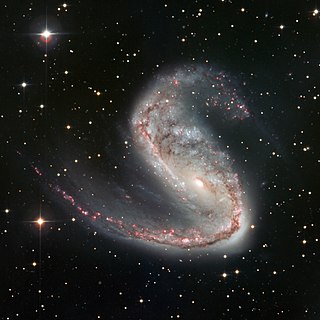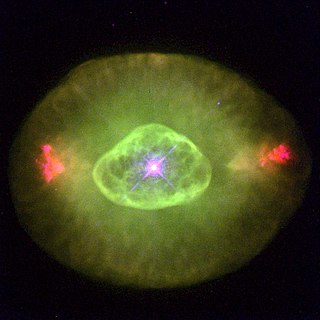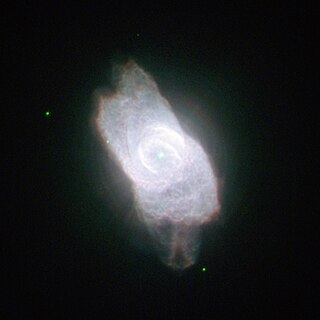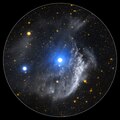
The Cat's Eye Nebula is a planetary nebula in the northern constellation of Draco, discovered by William Herschel on February 15, 1786. It was the first planetary nebula whose spectrum was investigated by the English amateur astronomer William Huggins, demonstrating that planetary nebulae were gaseous and not stellar in nature. Structurally, the object has had high-resolution images by the Hubble Space Telescope revealing knots, jets, bubbles and complex arcs, being illuminated by the central hot planetary nebula nucleus (PNN). It is a well-studied object that has been observed from radio to X-ray wavelengths.

The Eskimo Nebula, also known as the Clown-faced Nebula, Lion Nebula, or Caldwell 39, is a bipolar double-shell planetary nebula (PN). It was discovered by astronomer William Herschel in 1787. The formation resembles a person's head surrounded by a parka hood. It is surrounded by gas that composed the outer layers of a Sun-like star. The visible inner filaments are ejected by a strong wind of particles from the central star. The outer disk contains unusual, light-year-long filaments.

The Saturn Nebula is a planetary nebula in the constellation Aquarius. It appears as a greenish-yellowish hue in a small amateur telescope. It was discovered by William Herschel on September 7, 1782, using a telescope of his own design in the garden at his home in Datchet, England, and was one of his earliest discoveries in his sky survey. The nebula was originally a low-mass star that ejected its layers into space, forming the nebula. The central star is now a bright white dwarf star of apparent magnitude 11.5. The Saturn Nebula gets its name from its superficial resemblance to the planet Saturn with its rings nearly edge-on to the observer. It was so named by Lord Rosse in the 1840s, when telescopes had improved to the point that its Saturn-like shape could be discerned. William Henry Smyth said that the Saturn Nebula was one of Struve's nine "Rare Celestial Objects".

NGC 2442 and NGC 2443 are two parts of a single intermediate spiral galaxy, commonly known as the Meathook Galaxy or the Cobra and Mouse. It is about 50 million light-years away in the constellation Volans. It was discovered by Sir John Herschel on December 23, 1834 during his survey of southern skies with a 18.25 inch diameter reflecting telescope from an observatory he set up in Cape Town, South Africa. Associated with this galaxy is HIPASS J0731-69, a cloud of gas devoid of any stars. It is likely that the cloud was torn loose from NGC 2442 by a companion.

NGC 6302 is a bipolar planetary nebula in the constellation Scorpius. The structure in the nebula is among the most complex ever observed in planetary nebulae. The spectrum of NGC 6302 shows that its central star is one of the hottest stars known, with a surface temperature in excess of 250,000 degrees Celsius, implying that the star from which it formed must have been very large.

The Veil Nebula is a cloud of heated and ionized gas and dust in the constellation Cygnus.

The Caldwell catalogue is an astronomical catalogue of 109 star clusters, nebulae, and galaxies for observation by amateur astronomers. The list was compiled by Patrick Moore as a complement to the Messier catalogue.
The Herschel 400 catalogue is a subset of William Herschel's original Catalogue of Nebulae and Clusters of Stars, selected by Brenda F. Guzman (Branchett), Lydel Guzman, Paul Jones, James Morrison, Peggy Taylor and Sara Saey of the Ancient City Astronomy Club in St. Augustine, Florida, United States c. 1980. They decided to generate the list after reading a letter published in Sky & Telescope by James Mullaney of Pittsburgh, Pennsylvania, USA.

NGC 2022 is a planetary nebula in the equatorial constellation of Orion, located at a distance of 8.21 kilolight-years from the Sun. It was first observed by William Herschel on December 28, 1785, who described it as: considerably bright, nearly round, like a star with a large diameter, like an ill-defined planetary nebula. In medium-sized amateur telescopes it looks like a small grayish patch of light. It is not very bright but it is still easy to spot it in the eyepiece. Even in a telescope as small as 80mm it can just be seen using a narrowband filter such as an OIII filter as a 'fuzzy' star. The object has the shape of a prolate spheroid with a major to minor axis ratio of 1.2, an apparent size of 28″, and a halo extending out to 40″, which is about the angular diameter of Jupiter as seen from Earth.

NGC 7662 is a planetary nebula located in the constellation Andromeda.

NGC 2867 is an elliptical Type II planetary nebula in the southern constellation of Carina, just over a degree to the NNW of the star Iota Carinae. It was discovered by John Herschel on April 1, 1834. Herschel initially thought he might have found a new planet, but on the following night he checked again and discovered it had not moved. The nebula is located at a distance of 7,270 light-years from the Sun.

NGC 2261 is a variable nebula located in the constellation Monoceros. The nebula is illuminated by the star R Monocerotis, which is not directly visible itself.

NGC 3195 is a planetary nebula located in the southern constellation of Chamaeleon. It is the most southern of all the bright sizable planetary nebula in the sky, and remains concealed from all northern observers. Discovered by Sir John Herschel in 1835, this 11.6 apparent magnitude planetary nebula is slightly oval in shape, with dimensions of 40×35 arc seconds, and can be seen visually in telescopic apertures of 10.5 centimetres (4.1 in) at low magnifications.

NGC 6826 is a planetary nebula located in the constellation Cygnus. It is commonly referred to as the "blinking planetary", although many other nebulae exhibit such "blinking". When viewed through a small telescope, the brightness of the central star overwhelms the eye when viewed directly, obscuring the surrounding nebula. However, it can be viewed well using averted vision, which causes it to "blink" in and out of view as the observer's eye wanders.

NGC 2371-2 is a dual lobed planetary nebula located in the constellation Gemini. Visually, it appears like it could be two separate objects; therefore, two entries were given to the planetary nebula by John Louis Emil Dreyer in the New General Catalogue, so it may be referred to as NGC 2371, NGC 2372, or variations on this name. It has also been called the double bubble nebula.

NGC 1535 is a planetary nebula in the constellation of Eridanus, discovered by William Herschel on February 1, 1785. It is very similar to the Eskimo Nebula in both color and structure but the central star can be quite difficult to observe visually.

Little Ghost Nebula, also known as NGC 6369, is a planetary nebula in the constellation Ophiuchus. It was discovered by William Herschel.

IC 3568 is a planetary nebula that is 1.3 kiloparsecs away from Earth in the constellation of Camelopardalis. It is a relatively young nebula and has a core diameter of only about 0.4 light years. It was dubbed the Lemon Slice Nebula by Jim Kaler, due to its appearance in one false-colour image from the Hubble Space Telescope. The Lemon Slice Nebula is one of the most simple nebulae known, with an almost perfectly spherical morphology. The core of the nebula does not have a distinctly visible structure in formation and is mostly composed of ionized helium. A faint halo of interstellar dust surrounds the nebula. The central star of the planetary nebula is an O-type star with a spectral type of O(H)3.

NGC 6572 is a planetary nebula with magnitude 8.1, easily bright enough to make it an appealing target for amateur astronomers with telescopes. NGC 6572 is a young planetary nebula. NGC 6572 began to shed its gases a few thousand years ago. Because of this, the material is still quite concentrated, which explains its abnormal brightness. The envelope of gas is currently racing out into space at a speed of around 15 kilometres per second. As it becomes more diffuse, it will dim. It is located within the large constellation of Ophiuchus and at low magnification, it will appear to be just a colored star, but higher magnification will reveal its shape. NGC 6572 was discovered in 1825 by the German astronomer Friedrich Georg Wilhelm von Struve. According to several sources such as Sky & Telescope, this object received the nicknames Blue Racquetball, Emerald Nebula, Green Nebula, Turquoise Orb.

NGC 1501 is a complex planetary nebula located in the constellation of Camelopardalis, discovered in 27 Aug 1787 by William Herschel. It is also known as the Oyster Nebula.























